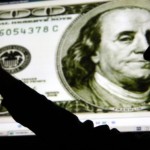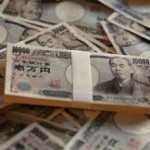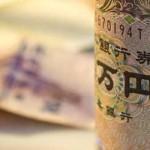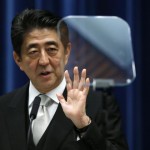Yen Falls as Russia Eases Ukraine Tension

The yen fell versus 14 of its 16 major peers as concern eased about tensions in Ukraine after reports last week that Russia’s warplanes ended drills and the nation is seeking to mediate between Kiev and rebel forces.
The dollar held gains from last week against most Group of 10 currencies as traders added to bullish bets on the greenback at the fastest pace in more than a year. Demand was bolstered before a report this week predicted to show U.S. retail sales grew for a sixth month. Indonesia’s rupiah rose the most in a month on bets judges will dismiss a challenge to incoming president Joko Widodo’s election victory.
“The headline that Russia is looking to deescalate the Ukrainian situation has seen a bit of stability return to the market,” said Sam Tuck, a senior currency strategist at ANZ Bank New Zealand Ltd. “We’re reversing some of the flight to safety.”
The yen fell 0.1 percent to 102.11 per dollar as of 7:22 a.m. in London after reaching 101.51 on Aug. 8, the strongest since July 24. It was at 136.80 versus the euro from 136.83. The 18-nation euro slid 0.1 percent to $1.3397.
The Bloomberg Dollar Spot Index, which tracks the greenback against 10 developed-market peers, was little changed at 1,021.81, holding four straight weeks of gains.
Russian Mediation
Pro-Russian rebels offered a truce on humanitarian grounds that Ukraine’s military dismissed yesterday as lacking in substance, pushing ahead with a campaign to put down the uprising in the country’s east. Interfax reported that Russia’s Defense Ministry said last week that warplanes ended drills in the region near Ukraine. RIA Novosti said Russia is ready to mediate between Ukraine and the rebels, citing Russian Security Council head Nikolai Patrushev.
“If the Ukrainian government and pro-Russian separatists engage in a dialogue, stock gains and a rise in Treasury yields could spur some dollar buying,” said Toshiya Yamauchi, a senior analyst in Tokyo at Ueda Harlow Ltd., which provides margin-trading services. “The yen is likely to come under selling pressure as geopolitical risks take a back seat.”
The yen declined as Japanese stocks rose after the nation’s Health Ministry said the 126.6 trillion yen ($1.2 trillion) Government Pension Investment Fund has flexibility with deviation limits on assets.
Stocks Allocation
Removing the limits would enable GPIF to allocate more of its holdings to domestic stocks before changing its target for the asset class in an upcoming review. The fund is expected to boost its goal for local shares to about 20 percent of its portfolio around September from the current level of 12 percent, according to median estimate from a Bloomberg survey of analysts in May.
The Topix (TPX) index of Japanese shares jumped 2 percent, its biggest advance since April 16. The MSCI Asia Pacific Index (MXAP) added 1.2 percent.
Futures traders increased their bets that the yen will decline against the U.S. dollar to the most in almost five months, figures from the Washington-based Commodity Futures Trading Commission show. The difference in the number of wagers by hedge funds and other large speculators on a decline in the yen compared with those on a gain — so-called net shorts — was 95,399 in the week ended Aug. 5, the most bearish since March 14.
Election Result
An Indonesian court last week questioned evidence provided by losing presidential candidate Prabowo Subianto, who says Widodo’s victory is invalid because it was obtained “unlawfully” or through “abuse of authority” by the election commission. Chief Justice Hamdan Zoelva ordered the commission, the election supervisory agency and Widodo’s legal team to respond to the suit by today.
The rupiah advanced 0.9 percent to 11,664 per dollar, the biggest gain since July 7, prices from local banks show.
A gauge of currency price swings rose to a two-month high last week. JPMorgan Chase & Co.’s Global FX Volatility Index was at 6.2 percent after reaching 6.33 percent on Aug. 7, the most since June 4 and up from an all-time low on a closing basis of 5.29 percent on July 3.
In the U.S., retail sales probably increased 0.2 percent last month after a 0.2 percent advance in June, according to the median estimate of economists surveyed by Bloomberg News before the Commerce Department figures on Aug. 13.
The Fed cut monthly bond purchases by $10 billion for a sixth consecutive meeting last month to $25 billion. The next policy decision is due on Sept. 17. Futures traders are pricing in a 70 percent chance of an increase in the Fed’s benchmark rate to at least 0.5 percent by September 2015.
Bullish Futures
Aggregate net futures positions wagering on gains in the U.S. currency against major peers — the yen, euro, pound, Swiss franc, Mexican peso and the dollars of Australia, Canada and New Zealand — rose 115,893 to 129,190 in the week ended Aug. 5, the biggest increase in bullish bets since February 2013.
“U.S. dollar-long positioning still seems to be a favorite of the market, and that’s all coming from the U.S. data,” said ANZ’s Tuck. “The U.S. is definitively making progress toward the Fed’s twin goals, and the market is debating the timing of the first rate hike, and has been bringing it forward.”
Source: Bloomberg





























